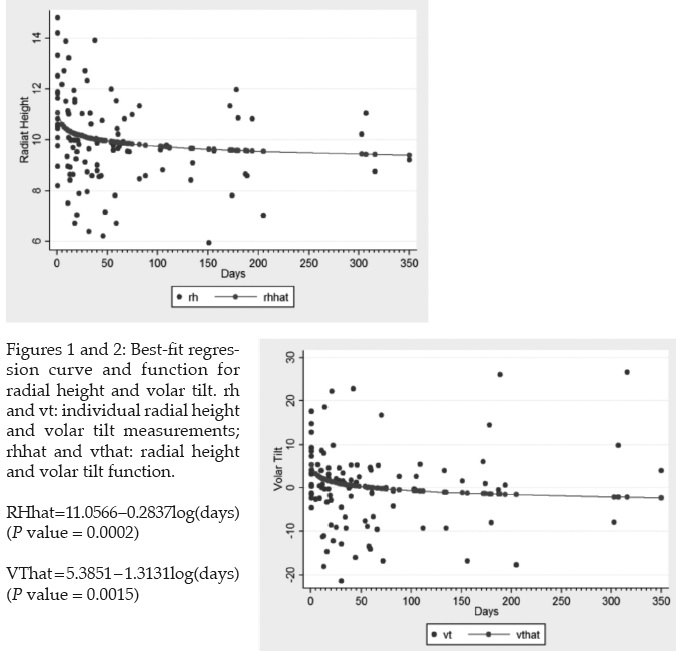
Session IX - Upper Extremity
Sat., 10/12/13 Upper Extremity, PAPER #105, 3:24 pm OTA 2013
When Do Distal Radius Fractures Most Likely Displace and When Do They Stop Moving: Long-Term Follow-up of Closed Reduction and Casting
Andrew Jawa, MD; Joey Lamartina, MD; Paul Tornetta, III, MD;
Boston University Medical Center, Boston, Massachusetts, USA
Background/Purpose: Distal radius fractures treated with closed reduction and casting lose position over a long time frame. Although most surgeons immobilize these fractures for 4 to 6 weeks, little data exist predicting when these fractures are most likely to lose reduction and when they ultimately stop moving. Our goal was to use a large data set of radiographic measurements, specifically volar tilt and radial height, for regression analysis in order to determine the change in these parameters over long-term follow-up.
Methods: We prospectively screened 546 consecutive distal radius fractures. We excluded patients with <10° of dorsal tilt upon presentation, leaving 275 fractures of which 168 were treated nonoperatively with closed reduction and casting. Patients were managed with short arm casts and seen every other week in the clinic by an attending orthopaedic trauma surgeon until 6 weeks and then at the discretion of the treating surgeon. Patients were recasted if there was thought to be a shift in the fracture position or if the cast became loose. We excluded patients with less than 150 days of follow-up, measuring the radial height and volar tilt on initial injury film, postreduction, and all subsequent follow-ups in order to perform a regression analysis and place a best-fit curve for 96 measurements for each parameter. Based on this function, we calculated the number of days when 50%, 75%, and 95% of change occurred relative to 1 year, when full healing is presumed.
Results: Using regression analysis, we placed a best fit curve and determined the function for both radial height and volar tilt (Figures 1 and 2). Based on this function, we found a logarithmic curve in which 50% of the radial height is lost in approximately the first 30 days after reduction, 75% is lost in the first 82 days, and 95% is lost by day 278. Similarly, for volar tilt, 50% loss in reduction is seen in the first 18 days, 75% is lost in the first 81 days, and 95% is lost by day 263.
Discussion/Conclusion: Our goal was to use a large data set of radiographic measurements, specifically volar tilt and radial height, for regression analysis in order to determine the change in these parameters over longer-term follow-up. We found that 50% of the primary reduction parameters of radial height and volar tilt are lost in approximately the first 4 weeks after reduction, but loss continues to occur at a slower rate up until approximately 9 months. The majority of radial height and volar tilt are lost in the first 30 days after closed reduction and casting of distal radius fractures; however, the reduction continues to shift up to nearly 1 year. Because both loss of radial height and volar tilt have been implicated in long-term wrist dysfunction, these data are important in predicting both immediate and long-term radiographic outcomes of patients and may be important in early discussions regarding treatment.
Figures 1 and 2:

Alphabetical Disclosure Listing
• The FDA has not cleared this drug and/or medical device for the use described in this presentation (i.e., the drug or medical device is being discussed for an “off label” use). ◆FDA information not available at time of printing. Δ OTA Grant.